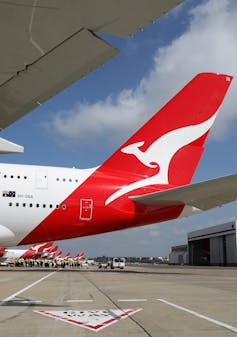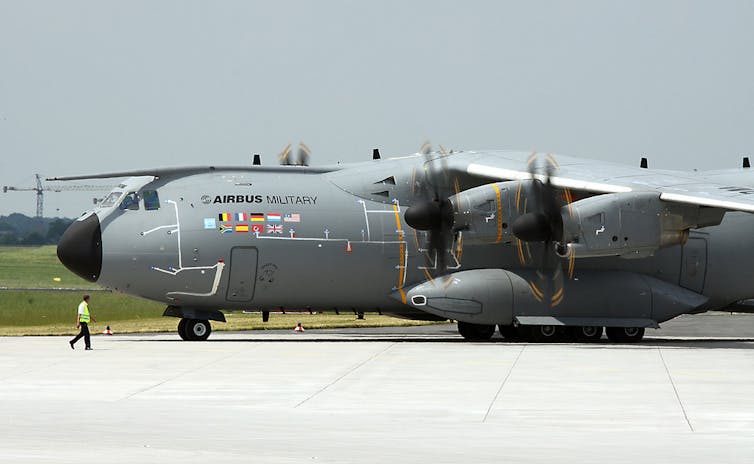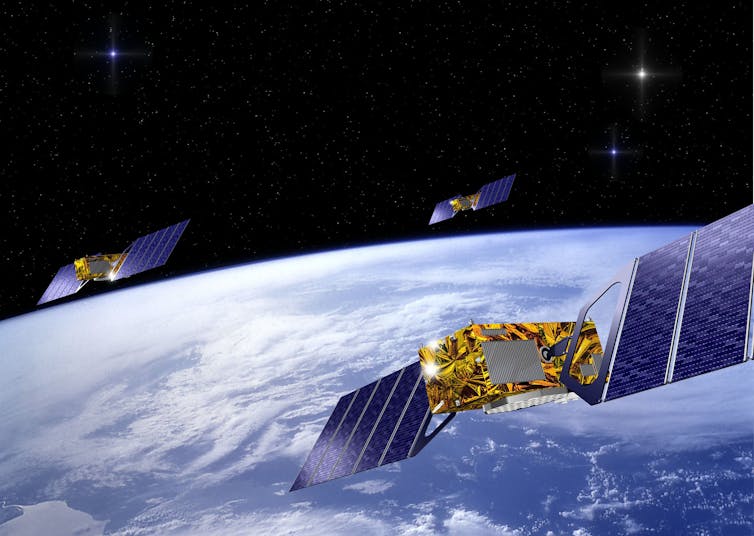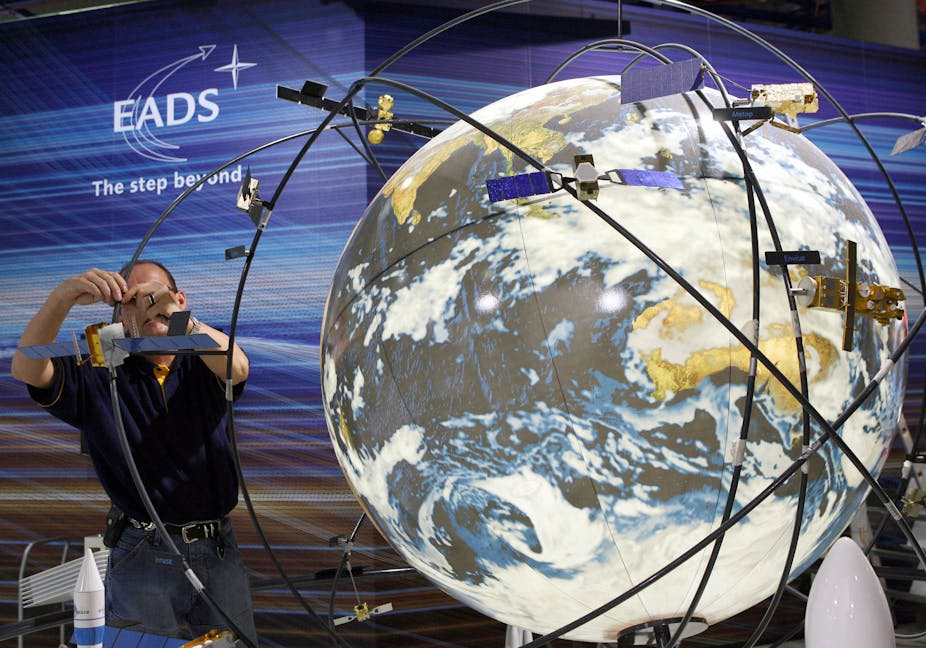Welcome to “The most powerful companies you’ve never heard of” – an ongoing series from The Conversation that sheds light on big companies with low profiles. Today, Monash University’s Remy Davison examines European aircraft and weapons manufacturer EADS.
You may have never heard of the European Aeronautic Defence and Space Company (EADS), but it is likely that you have travelled on an aircraft manufactured by its high-profile subsidiary, Airbus.
The Airbus A320 shuttles thousands of passengers daily on short-haul flights throughout Australia and around the world.
Qantas took its first deliveries of the Airbus A380 in late 2008, with its superjumbo fleet now totalling 10 aircraft. The planes have cost the airline about $350 million each.
But civil aviation isn’t EADS’s only business.
The company, headquartered in the Dutch city of Leiden, is listed simultaneously on six European stock exchanges, including the London, Paris, Frankfurt and Madrid bourses.
EADS is also seriously cashed-up: as of last month, it had $US16 billion in cash.

It is also perhaps the only truly transnational, integrated firm in the European Union. It draws its engineering talent and management from throughout Europe, and employs well over 100,000 workers.
Less well known are EADS’s other major products: weapons.
With almost $US16 billion in sales in 2009, it is one of the world’s largest armaments manufacturers. Its Dornier aircraft and Euromissile subsidiaries account for a considerable proportion of its anual revenue of $US50 billion.
A merger deal in 2003 saw Euromissile come under the control of trans-European weapons manufacturer MBDA, which used to be known as Messerschmitt-Bölkow-Blohm. Yes, that’s the same Messerschmitt that lit up London’s skies during the Blitz.
Among other things, MBDA builds guided missile systems and state-of-the-art anti-tank missiles.
MBDA is 37.5% owned by EADS, with BAe Systems – better-known as British Aerospace – taking another 37.5%.
Italy’s partly state-owned Finmeccanica, a major aerospace and defence conglomerate, controls the remaining 25%.
Ownership obscured
Who controls EADS? Well, it’s complicated.
Most of EADS’s stock is not publicly listed on financial markets. Instead there is a “gentlemen’s agreement” that sees the company rest firmly under the control of two Franco-German conglomerates.
SOGEADE, a holding company that is majority-controlled by the French government and media firm Lagardère, has 22.5% of EADS, while German giant Daimler holds 22.5%.
That’s right – Daimler. Better known for its Mercedes-Benz cars, Daimler has been in the aerospace business for decades. But in August this year, Daimler indicated it was seeking to divest itself of EADS shares, with German private investors likely to have first refusal.
EADS’s piece de resistance is the Spanish-assembled Airbus A400M, a long-haul military transporter designed to eliminate the EU’s dependence upon US-owned Boeing C-17s and rented Ukrainian Antonovs.
The A400M’s principal customers are the French, German and British governments, although smaller orders have been received from other countries.

But while the A400M is EADS’s military flagship, it has also proved its bugbear.
In 2005, 17 EADS executives from Daimler and Lagardère, together with then-CEO Thomas Enders, cashed out their considerable stock holdings. They reaped significant gains from EADS’s share price, which was fattened largely on the basis of prospective A400M orders and the announcement of the A380 superjumbo.
But shortly afterwards, the A400M – no more than a cardboard model in 2005 – faced delay after frustrating delay. From 192 “firm” orders in 2007, 400M confirmed sales plummeted to 174.
Germany cut its order from 73 to 53, while France plans to take 50. More more than 50% of orders rely upon Berlin and Paris. South Africa cancelled its eight-aircraft order, while Airbus lost out to Boeing in Canada. Chile, which showed early interest, has gone for Brazilian aircraft instead.
Following the stock sales, it was revealed that the A380 was the victim of significant engineering problems, of which EADS shareholders were unaware in 2005. Further A380 delivery delays were announced in 2006, causing a stock collapse of over 25% in 24 hours.
Few Europeans would ever have heard of EADS until before this affair. But the executives’ stock sales in 2005 elicited widespread condemnation from shareholders and media accusations of millions of dollars in unlawful gains, triggering a 2009 investigation of alleged insider dealing.

Although the regulator called for substantial fines of the executives, all were cleared by a subsequent French inquiry.
Into space
Perhaps the most controversial EADS project is its space subsidiary’s involvement in the EU’s GPS program, Galileo.
China has invested €230 million in Galileo, which is a 30-satellite program. This means that China could acquire satellite guidance systems for air-to-ground ordnance for a mere $US18,000 a piece, making the country entirely independent of the United States’ satellite system.
The loophole that makes Galileo’s infrastructure available to China relates to the notion that, under EU rules, satellite systems are “dual use” – for civilian and military purposes. This is despite a longstanding EU embargo on arms and military-related exports to China, in place since 1989.
Given that China is also developing laser systems capable of destroying satellites, this could not only render US guidance systems inoperable, but mean that China would retain its own use of Galileo, making it entirely autonomous of the US GPS system.
Let us not forget that nuclear and conventional missiles are GPS-guided.
Quite publicly, American officials have stated that in the event of armed conflict with China, US forces would have no other option but to destroy Galileo entirely.
If China blew the US GPS out of the sky, the US would have no satellite capability, while China would still have Galileo. The EU may protest Galileo is a civilian system, but the Pentagon clearly views its military deployment capabilities as a threat to US national security.
The battle for aerospace
Back in 1987, the EU initiated the ambitious European Single Market program, of which the euro is a concomitant part.
By 2002, both the euro and the Single Market were firmly established. But what Europe lacked was an integrated single market in defence procurement, with British, German, French, Italian and Spanish firms engaging in product duplication. Economies of scale were non-existent.
In 1999, the EU promulgated the European Security and Defence Policy (ESDP), a thinly-veiled rival to NATO. But ESDP relied – and still does, largely – upon NATO military assets.
And although the EU has the world’s second-largest defence budget, it imports 40% of its defence materiel from the US.

To realise efficiencies in defence procurement, Brussels created the European Defence Agency (EDA), an office designed to encourage mergers, acquisitions and joint R&D defence projects.
By far the biggest beneficiary of an integrated EU armaments market has been EADS. Without ESDP, neither the Airbus A400M nor the Eurofighter Typhoon would have come to fruition (the latter spent most of the 1990s in limbo as EU governments fought over its funding).
The bottom line is that the EU would have lost both the civil and military aviation war to the US had it not sought to beat Boeing through industrial integration and subsidies.
EADS became the trans-European conglomerate that made EU aerospace viable and competitive in global markets, albeit via significant government intervention and massive defence contracts.
Abortive attempts by President Chirac and former German Chancellor Gerhard Schroeder to remove the EU arms embargo on China in 2005 also angered Pentagon officials, who view the EU’s relations with Beijing as too cosy by half.
And, as EADS branches out into more controversial joint projects with China, such as Galileo, EU-US defence relations are likely to remain mired in a mutuality of suspicion.
Is there a big company with a low profile that you think more people should know about? If so, email the editor.

